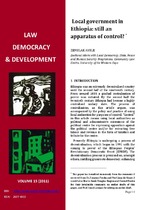| dc.contributor.author | Ayele, Zemelak | |
| dc.date.accessioned | 2014-05-30T14:10:37Z | |
| dc.date.available | 2014-05-30T14:10:37Z | |
| dc.date.issued | 2011 | |
| dc.identifier.citation | Ayele, Z. (2011). Local government in Ethiopia: still an apparatus of control?. Law, Democracy and Development, 15: 1-27 | en_US |
| dc.identifier.issn | 2077-4907 | |
| dc.identifier.uri | http://hdl.handle.net/10566/1092 | |
| dc.description.abstract | Historically, local authorities in Ethiopia enjoyed wide political, administrative, judicial, and financial autonomy. However, from the 1850s a process of territorial expansion and centralisation was initiated in the country.
The centralisation process reached its zenith under the rule of Colonel Mengistu in the 1980s. This centralisation gradually diminished the autonomy of local authorities which incrementally became structures of control of the central government. Local authorities were used to actively suppress resistance against the central government, extract revenue in the form of tax and tribute, mobilise free labour, and even act as agents to conscript for the army. This policy and practice continued until Colonel Mengistu was ousted by the Ethiopian People’s Revolutionary Democratic Front (EPRDF) in 1991. Soon after seizing power, the EPRDF declared its intention to reverse the century-long centralised rule and introduced a semi-federal structure in the country in 1991. Ethiopia officially became a federal country in 1995 following the promulgation of a new Constitution. In 2001 a local level decentralisation programme was initiated. The decentralisation programme included the establishment of elected local government structures and the devolution of certain political, administrative and financial powers to local government.
This paper seeks to demonstrate how local authorities were used as a means of control in the past. While a decentralised system of governance has formally been introduced in Ethiopia, this paper argues that local authorities still remain instruments of political control by the central government. In so doing it highlights the factors that continue the trend of central control of local government despite extensive formal decentralisation. | en_US |
| dc.language.iso | en | en_US |
| dc.publisher | University of the Western Cape | en_US |
| dc.rights | © 2011 Ayele; licensee University of the Western Cape. This is an Open Access article distributed under the terms of the Creative Commons Attribution License (http://creativecommons.org/licenses/by/3.0), which permits unrestricted use, distribution, and reproduction in any medium, provided the original work is properly cited. | |
| dc.subject | Local government | en_US |
| dc.subject | Ethiopia | en_US |
| dc.subject | Ethiopian Peoples’ Revolutionary Democratic Front (EPRDF) | en_US |
| dc.title | Local government in Ethiopia: still an apparatus of control? | en_US |
| dc.type | Article | en_US |
| dc.privacy.showsubmitter | false | |
| dc.status.ispeerreviewed | true | |
| dc.description.accreditation | Department of HE and Training approved list | en_US |

